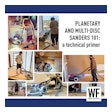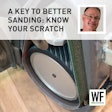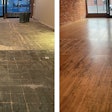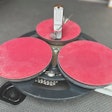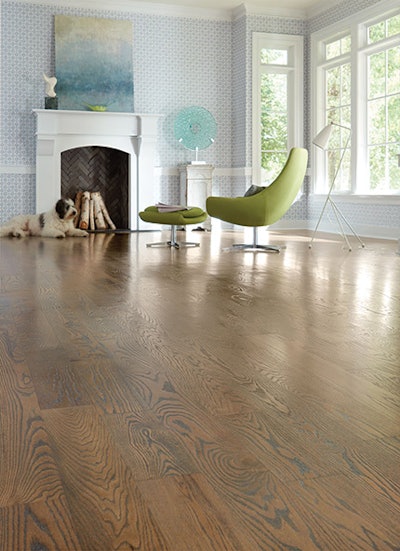
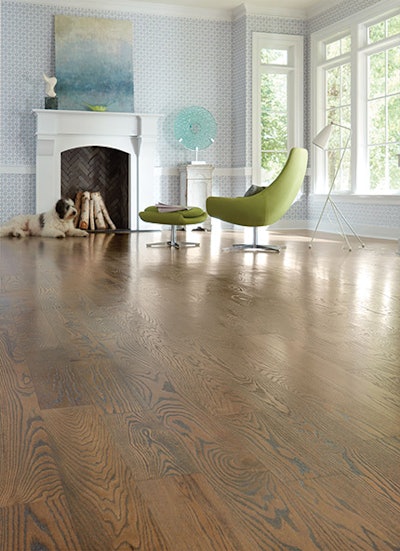 The custom white oak floor above was created by using one coat of Craft Oil 2K Clay; one coat of Craft Oil 2K Ash, wire-brushing and steel plates; then a topcoat of Bona Traffic HD.
The custom white oak floor above was created by using one coat of Craft Oil 2K Clay; one coat of Craft Oil 2K Ash, wire-brushing and steel plates; then a topcoat of Bona Traffic HD.
 The white oak floor in the two photos above had one coat of Bona Craft Oil 2K Air and one coat of a custom mix of Clay, Ash, Garnett and Neutral. The texture process included wire-brushing and steel plates.
The white oak floor in the two photos above had one coat of Bona Craft Oil 2K Air and one coat of a custom mix of Clay, Ash, Garnett and Neutral. The texture process included wire-brushing and steel plates.
When it comes to sanding a floor, we all know there is more than one way to get from point A to point B. We also know that homeowners today expect their floors to be the head-turning, jaw-dropping, HGTV-quality type of floors that they see marketed every day. As craftsmen, we need to be able to deliver what the homeowner wants by using state of the art technology and innovative sanding solutions. Let's take it back to the basics: abrasives, machines, accessories.
 Carefully choosing modern-day abrasives with optimized mineral blends for each cut can make a huge difference in your final product.
Carefully choosing modern-day abrasives with optimized mineral blends for each cut can make a huge difference in your final product.
Abrasives
When choosing abrasives, don't miss out on today's technical advances in floor sanding abrasives. Specialized products that work better on hardwood floor sanding machines and provide a better surface profile are out there just waiting for you. Choosing these modern-day abrasives with optimized mineral blends for each cut can make a huge difference in your final product.
Start your first cut with a ceramic grain blend that allows for fast and efficient removal of stubborn finishes or for cutting down over/underwood without leaving too many deep scratches. For instance, Bona Green Abrasives allow you to start at a higher grit than you would normally, shortening your sanding progression in the long run by having fewer cuts to make.
For your medium cuts, choose an abrasive with a blend of zirconia and silicon carbide, like Bona Blue. The zirconia acts as the muscle, removing the previous grit's scratches, while the silicon carbide helps soften and feather out the zirconia's scratches.
For your final sanding sequence, go with a paper that can provide consistent scratch patterns across the entire floor. Bona Black or Bona Diamond Abrasives provide a finished appearance with the least amount of visible scratches, leaving the best surface possible for optimal adhesion.
 Multi-head sanding machines such as this Bona Power Drive are easier to learn, easier to run, and increase your efficiency in creating the perfect surface.
Multi-head sanding machines such as this Bona Power Drive are easier to learn, easier to run, and increase your efficiency in creating the perfect surface.
 Adding weight to your machine, as shown here on the Bona Power Drive, increases the pressure, providing more aggressive sanding.
Adding weight to your machine, as shown here on the Bona Power Drive, increases the pressure, providing more aggressive sanding.
Machines
For your medium, fine, and extra-fine sanding cuts, consider using a machine that utilizes a multi-head driver, as these units tend to cancel out each head's scratches and leave the smoothest floor possible for staining, sealing and finishing. Belt sanders, the traditional work horse of our industry, have their benefits, offering speed and power for the coarse cut; but they have their limitations as well. Belt sanders are harder on your body, leave much more to edge, and have the potential to leave start/stop marks, drum marks, and chatter. Multi-head units are easier to learn, easier to run, and increase your efficiency in creating the perfect surface!
Accessories
Plates: Hard-plating has traditionally been used to achieve the flattest floor possible because it prevents dishing out the soft grain. This is a must-use technique when sanding parquet patterns and multi-species floors, as traditional screening or fine-sanding will lead to dish-out of the softer species. Dedicated, flat, hard-plate drivers can be used, as well as adding steel plates to your multi-head-type sanding machines.
Weights: Adding weight to your machine increases the pressure, providing more aggressive sanding. When used during the first or second cut, this can assist in the removal of multiple coats of finish, in flattening a new install, and helping to remove the previous cut's scratches. As your sanding sequence progresses and moves toward finer sanding, reduce the weight used, eventually removing all extra weight for your extra-fine preparation. On dense, uniform-grained species, you may want to reverse the process; adding no weights for the coarse cut, then gradually adding weight to assist the medium and fine grits in removing scratches from the previous steps.
Wire Brushes: For a uniquely textured floor, opt for using wire brushes. Sand the floor up to 80- or 100-grit, then switch out your abrasives for wire brush pucks. Bona's Wire Brush System, used with the Bona Power Drive, removes the soft grain of the wood, leaving the more durable hard grain and providing a deep, naturally textured appearance. Wetting the floor with water ahead of the Power Drive will make it easier to remove the soft grain while also keeping the brushes cooler. Edges can be taken care of first by using a wire brush puck mounted on an angle grinder.
Achieving the different flat, natural, or deeper textured surfaces that you and your customers desire may take a bit of careful planning; but by using a combination of these tools and techniques, you can achieve brilliant, beautiful floors, and help yourself stand out from the competition.




















